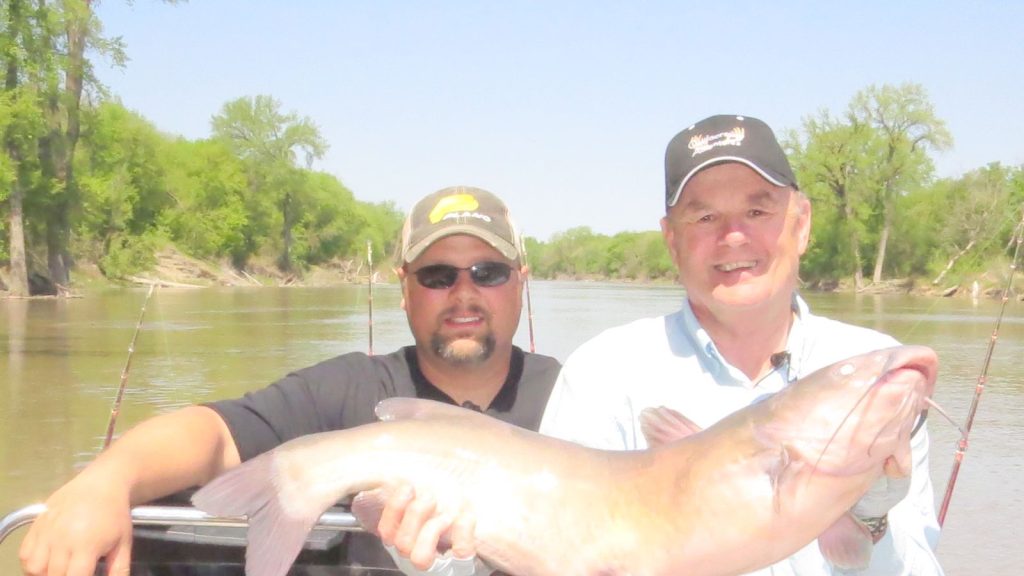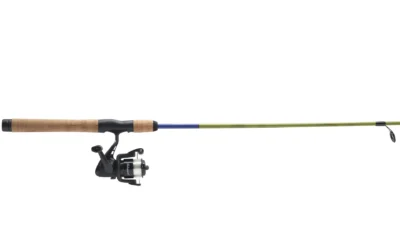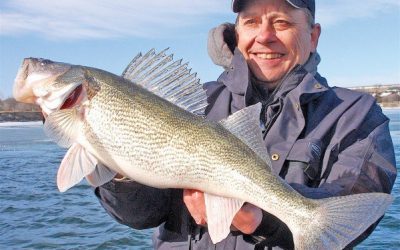Larry Myhre and Gary used Heavy rods & reels when they were fishing on the Red River for channel catfish, with Brad Durick Guide service. The catfish they caught weighed in from 15 to 25 pounds. (Photo by Lary Myhre)
When we’re doing seminars and in store promotions, one of the most often asked questions asked, deal with what type of rod should an angler use.
This column will deal with rod is recommendations by rod manufacturers and what rods will work for your type of fishing.
I’ll bet there were times when fishing you had trouble detecting a bite or were constantly setting the hook because the end of your wimpy rod was jumping all over the place?
There is a definite difference between rods and if not set up correctly, it will affect your bite detection and casting ability.
It’s the vibration on the end of your rod when trolling crankbaits, is the only way to tell if your bait is doing what it’s supposed to.
Some anglers don’t even look at the action of a rod before they purchase them. I like a lot of anglers have pushed them against the floor while others shake the rod to see how much give is in the end of the rod.
Sure, these are a couple of ways letting the angler see how stiff or fast the rod tip is, but you won’t know if the rod you’re buying the correct action has until you look at the manufacturer’s recommendations.
Look for the manufactures recommendations as far as lure size, line weight and the action of the rod, this information is located just above the handle on the rod blank.
If your drag is set too loose or too heavy, it doesn’t matter what rod your using as the drag needs to allow line to be released when the fish hits the bait and if not set properly, the games over.
When it comes to rod action, there are several size rods for each Particular
Below are some manufactures recommendations on which rod should work best for the type of fishing you’re doing.
* Ultra-light rods are set up to throw smaller 1/16 – 1/8 -ounce baits and spooled with 1-to-6-pound line, which works well when fishing for crappie and bluegills.
* Light power rods work well for walleye, larger panfish and trout using 1/8 – 1/4-ounce baits when spooled with 6-to-15-pound line.
* Medium-light rods work well when rigged with ¼ – 3/8-ounce baits using 6-to-12-pound test line. These are the rods I use for walleyes and smallmouth bass, a rod with a sensitive tip allowing me to detect the nibbler, yet strong enough to land a big fish.
* Medium power rods using 3/8 – 5/8-ounce baits and 6-to-15-pound test line work well for bass fishing in water with fewer snags. These rods are popular because they can handle so many different species of fish; work well for pulling cranks as well as finesse techniques for smallmouth and largemouth bass.
* Medium-Heavy, made for using heavy tackle and what you want in a rod when fishing for larger fish. When these rods are rigged using 5/8-to-1-ounce baits and spooled with 10-to-25-pound test line, they work very well when fishing for bass and pike in heavy cover.
* Heavy power rods set up with 3/4 – 1 1/4-ounce baits set up with 10-to-20-pound test line. are used on those hard charging big fish or in snag infested waters. Bass fishermen, pike and musky fishermen use these rods to rip fish from trees, brush and weedy areas.
When we’re doing seminars and in store promotions, one of the most often asked questions asked, deal with what type of rod should an angler use.
This column will deal with rod is recommendations by rod manufacturers and what rods will work for your type of fishing.
I’ll bet there were times when fishing you had trouble detecting a bite or were constantly setting the hook because the end of your wimpy rod was jumping all over the place?
There is a definite difference between rods and if not set up correctly, it will affect your bite detection and casting ability.
It’s the vibration on the end of your rod when trolling crankbaits, is the only way to tell if your bait is doing what it’s supposed to.
Some anglers don’t even look at the action of a rod before they purchase them. I like a lot of anglers have pushed them against the floor while others shake the rod to see how much give is in the end of the rod.
Sure, these are a couple of ways letting the angler see how stiff or fast the rod tip is, but you won’t know if the rod you’re buying the correct action has until you look at the manufacturer’s recommendations.
Look for the manufactures recommendations as far as lure size, line weight and the action of the rod, this information is located just above the handle on the rod blank.
If your drag is set too loose or too heavy, it doesn’t matter what rod your using as the drag needs to allow line to be released when the fish hits the bait and if not set properly, the games over.
When it comes to rod action, there are several.
Below are some manufactures recommendations on which rod should work best for the type of fishing you’re doing.
* Ultra-light rods are set up to throw smaller 1/16 – 1/8 -ounce baits and spooled with 1-to-6-pound line, which works well when fishing for crappie and bluegills.
* Light power rods work well for walleye, larger panfish and trout using 1/8 – 1/4-ounce baits when spooled with 6-to-15-pound line.
* Medium-light rods work well when rigged with ¼ – 3/8-ounce baits using 6-to-12-pound test line. These are the rods I use for walleyes and smallmouth bass, a rod with a sensitive tip allowing me to detect the nibbler, yet strong enough to land a big fish.
* Medium power rods using 3/8 – 5/8-ounce baits and 6-to-15-pound test line work well for bass fishing in water with fewer snags. These rods are popular because they can handle so many different species of fish; work well for pulling cranks as well as finesse techniques for smallmouth and largemouth bass.
* Medium-Heavy, made for using heavy tackle and what you want in a rod when fishing for larger fish. When these rods are rigged using 5/8-to-1-ounce baits and spooled with 10-to-25-pound test line, they work very well when fishing for bass and pike in heavy cover.
* Heavy power rods set up with 3/4 – 1 1/4-ounce baits set up with 10-to-20-pound test line. are used on those hard charging big fish or in snag infested waters. Bass fishermen, pike and musky fishermen use these rods to rip fish from trees, brush and weedy areas.





0 Comments